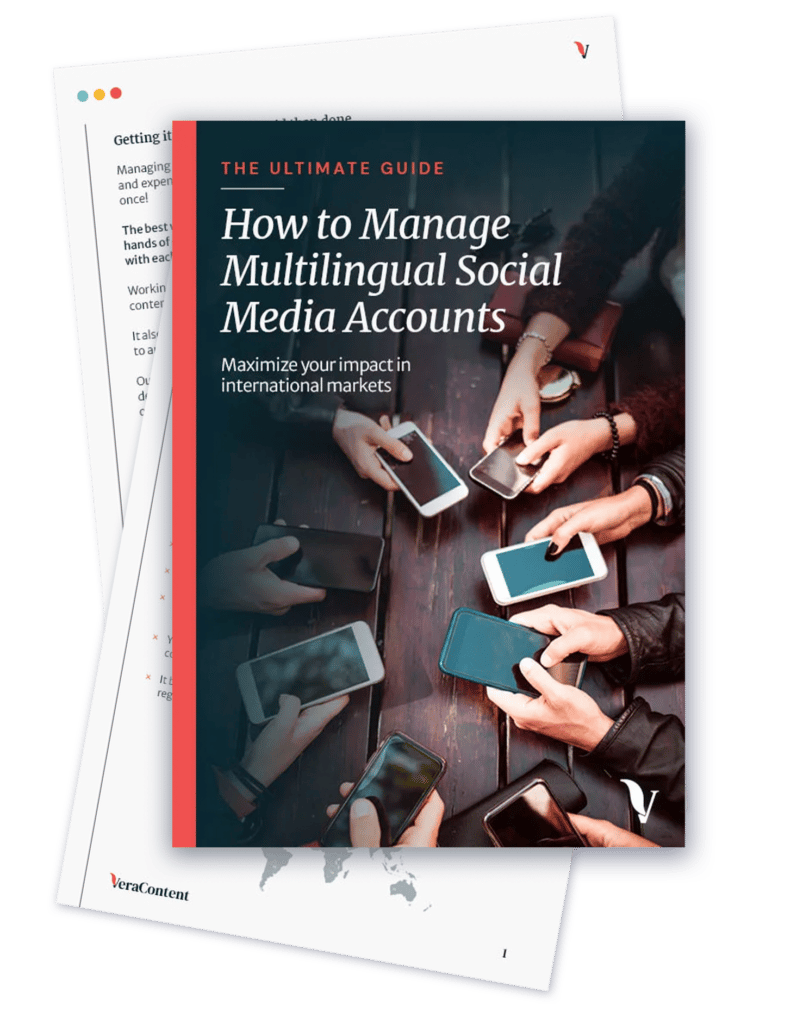Whether you’re a small startup or a large corporation, your global social media strategy can make or break your brand’s success. But with diverse audiences speaking different languages and living in various regions, how can you effectively navigate the global social media landscape?
Here are five essential things to know when managing a global social media presence—including when to go local.
Here’s our recap:
What is global social media?
62% of the world’s population uses social media. That’s 4.80 billion people scrolling through social platforms for an average of two hours and 23 minutes daily.
Seeing as social media consumes a considerable portion of people’s daily routine around the world, global social media marketing is an incredible opportunity for brands to reach international audiences.
Global social media involves creating globalized accounts on each relevant platform—such as Facebook, X (Twitter), Instagram, LinkedIn and TikTok—to target international audiences. This differs from localized social media, where brands create local accounts that target regional audiences.
Localization of social media content goes beyond linguistic translation—it’s about authentically capturing the pulse of local communities. By tailoring content to match the unique characteristics, cultures and preferences of different regions, brands can build stronger connections with their target markets.
If you’re sticking with a global social media presence, here are five essential things to know.
See also: Setting up design workflows for global social media accounts & How to use Meta Business Manager for global accounts

Essential #1: Platform preferences and usage vary across regions
Different regions have preferred social media platforms based on market location and demographic nuances.
For example, while Facebook maintains a strong global presence, its absence in China has led to the rise of platforms like Weibo and WeChat. Similarly, Germany’s job-seekers favor Xing over the more globally recognized LinkedIn, showcasing the significance of local preferences.
While Facebook and Instagram remain popular in Europe, fluctuations in user numbers indicate a changing landscape. It’s common for platforms to experience growth and decline, making it essential to adapt and evolve your strategy to stay relevant continuously.
It’s also important to keep an eye on emerging platforms. For example, WhatsApp’s growth in Europe indicates potential opportunities for brand engagement on the platform. While primarily known for messaging, WhatsApp can be used for customer service expansion.
Your target audience’s age range also plays a role in platform selections. Younger demographics often gravitate towards visually engaging platforms like TikTok and Instagram, whereas older age groups tend to be more active on Facebook.
See also: How to create a solid multilingual social media strategy
Essential #2: Cultures differ

When managing a global social media account, it’s important to avoid getting caught up in posting content with specific cultural references. They might not click with everyone.
Instead, think broad and universal. You need to find that sweet spot where your content speaks to everyone without stepping on anyone’s toes. Focus on themes everyone can get behind—emotions, stories or experiences that resonate worldwide.
The goal? Connect with people from all walks of life. Keep it positive, relatable and respectful. Skip the stereotypes or hyper-local stuff that might leave some scratching their heads.
Understanding and celebrating the beautiful tapestry of cultural differences while aiming for a global appeal is the way to go. It’s all about spreading positivity and building connections, no matter where your audience is from.
Essential #3: Not all events and trends are relevant in every region

Managing a global social media account means grasping that not all events or trends carry the same weight worldwide. While some events, like the Rugby World Cup, might be huge in certain countries, their allure might not extend universally.
Recognizable global celebrations such as Christmas, New Year’s Eve, Mother’s Day, Father’s Day and even Halloween are more universally understood and embraced. These occasions, though sometimes celebrated on different days in various countries, often have a broader appeal, making them suitable themes for a global audience.
Nevertheless, it’s crucial to be mindful of the various customs and adaptations these festivities have in different regions.
Additionally, social media trends don’t fit a single mold worldwide. What’s a hit in one part of the globe might not catch on in another. Understanding these differences is essential for a global social media strategy. Although challenging, it’s an opportunity to tailor content to match the distinct interests and tastes of each market.
It’s not just about recognizing what’s globally popular but also understanding what resonates within each specific community. This approach builds a deeper connection with audiences, acknowledging and respecting their unique traditions, ultimately leading to a more authentic and engaging global social media presence.
Essential #4: Timing and time zones

When managing a global social media account, time zones can be a bit of a puzzle. With everyone living in a different time zone, it’s tricky to figure out when to drop that perfect post.
Luckily, there are some handy tricks. Using tools that tell you when your audience is most engaged can be a game-changer. Tools like Buffer Analyze, Hootsuite AutoSchedule and SproutSocial help you pinpoint those prime hours in different time zones, letting you schedule posts when they’ll get the most views.
It’s equally important to stay tuned in to what’s happening globally, especially during natural disasters or crises. Awareness of significant events helps adjust your content strategy, ensuring your posts are respectful and considerate. Acknowledging and responding appropriately during these times shows empathy and support, fostering a sense of community among your diverse audience.
It’s about balancing timely, engaging content while being socially aware and responsible in the global conversation. A good international social media manager will know how and when to post certain localized posts.
“To produce content that connects with people, you have to be tuned in to what’s going on in the region. For example, something could happen tomorrow that makes a certain post inappropriate. So it’s super important to plan, but also to be versatile in your approach.”
– Kyler Canastra, head of business development at VeraContent
Essential #5: Not all influencers connect with global audiences
While local influencers can hold sway in their local or regional circles, their appeal might not transcend borders. What works in one place might not fly in another. Cultural nuances, language, and even humor vary, making it tricky for every influencer to strike a chord with a diverse global audience.
That’s why, when it comes to a global social media strategy, it’s crucial to choose influencers wisely. You need someone who can bridge cultures, speak the global language, and connect with a broad audience.
The key is finding influencers who understand and can adapt their content to suit the international stage, ensuring their message translates across different regions.
Not every influencer has that global spark, but the ones who do? They’re the real game-changers in the global influencer game.
See also: Global influencer marketing strategy: 3 key insights
Is global social media right for my marketing strategy?

Incorporating global social media into your marketing strategy can absolutely lead to growth, but it’s crucial to figure out the right approach for your business.
When global social media works:
- Expanding your reach: It’s perfect if you’re aiming to break into multiple markets, connect with diverse audiences and make your brand known globally.
- Uniform brand image: If you need a consistent brand image across different regions, a global approach keeps your message steady and often cuts down on marketing costs.
When going local makes more sense:
- Niche markets: If your product or service is tailored to a specific region’s preferences, a local strategy could nail it.
- Cultural relevance: Sometimes, a global campaign might not hit the right notes universally. Localized content with cultural references resonates better with regional audiences.
The sweet spot:
- Combination strategy: Some brands use a combo of both. Using global strategies to maintain consistency and local ones for targeting specific markets often brings the best of both worlds.
Ultimately, deciding between a global or local social media strategy boils down to your brand’s nature, audience and goals. For those seeking a wide impact and consistent brand image, global might be the go-to. But if you’re into niche markets and cultural specifics, a local approach might bring you closer to your audience.
Mixing and matching both strategies could just be the secret sauce for a killer marketing game plan.
We dive deeper into how to decide whether to go global or local in this blog post: Global vs. local social media accounts: How many do you need?
And, once you’ve decided how many accounts you need, check out: How to consolidate global social media pages: centralized vs. local approach
Download our free guide on how to manage multilingual social media accounts below:

Elevate your global presence with VeraContent
Partnering with the right global social media agency will allow you to scale your business internationally, without any stress. Though just one point of contact, you’ll have access to our team of vetted linguists and community managers worldwide.
Our insights into regional trends, ability to craft culturally sensitive content in multiple languages, and understanding of the most effective platforms can significantly enhance your brand’s global presence.
To maximize your brand’s potential on the global stage, reach out to VeraContent today and enquire about our marketing translation services. You could qualify for a Free Content Consultation.

